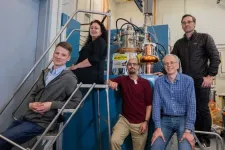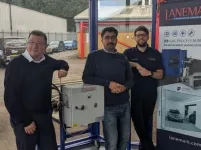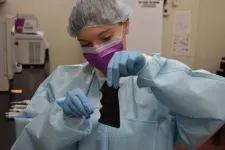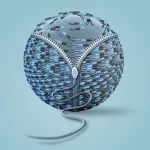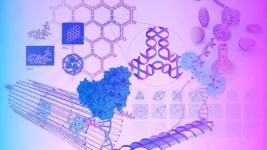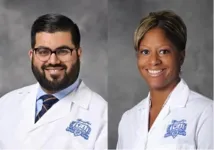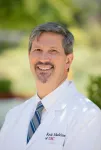One potential industrial use is in water treatment plants.
Per- and polyfluoroalkyl substances (PFAS) are present in many products, including certain non-stick cookware, water-resistant fabrics and shampoos. These PFAS find their way into drinking water, where they don’t break down and can’t be removed with traditional water-treatment methods. Though PFAS are linked to various health issues in humans, SRF accelerators could make these so-called “forever chemicals” not-so forever.
“Studies show that the electron beam generated by accelerators may be a promising way to break down PFAS and other pollutants in water, making them harmless,” said John Vennekate, a staff scientist at Jefferson Lab. He’s been working on developing compact accelerators for wastewater remediation with Gianluigi “Gigi” Ciovati, an accelerator scientist at Jefferson Lab.
Vennekate and Ciovati will continue and expand upon this work with $7.5 million from the DOE’s Accelerate initiative, which hopes to literally “accelerate” the translation of new technologies into industrial applications.
“This funding will help bridge the gap between our current proof of principle of this technology and a level where, with more time and investment, we could make a demonstrator that could be used by industry,” said Vennekate, who serves as principal investigator for this project.
For the next two years, the Jefferson Lab team will work with Fermi National Accelerator Laboratory, Florida International University, General Atomics, and other industry partners. The ultimate goal is to further develop a compact, high-power, and energy-efficient SRF accelerator that could one day be used in water treatment plants or other industrial settings, such as chemical processing plants.
Before that happens, this technology must be adapted from its lab-born origins.
For industry
In SRF accelerators, the components in which the electron beam travels are made out of niobium, which is a superconductor at very low temperatures. In the lab, scientists cool these components, called cavities, with liquid helium in cryogenic plants – systems that are too big, too expensive, and too complicated for industrial settings.
But if the niobium cavities are coated with a thin layer of an alloy called niobium-three-tin, which superconducts at higher temperatures than pure niobium, the cavities don’t have to be so cold. These cavities can be cooled with cryocoolers. Cryocoolers are refrigerator-sized machines that are cheaper and easier to operate than liquid helium plants. Both Jefferson Lab and Fermilab have demonstrated functioning SRF accelerator structures using niobium-three-tin coatings and commercial cryocoolers. This project will continue to advance adaptation of these structures.
When building prototypes in the past, Vennekate and the Jefferson Lab team used preexisting cavities built for liquid helium cooling. These recycled cavities had to be modified to work with a cryocooler. For this project, they will build a cavity specifically for this purpose.
“We have enough funding to design and build a cavity optimized for this application,” Vennekate said. “Starting from scratch, we can bring in lessons learned from previous experiments.”
Importantly, for this accelerator to work in an industrial setting, it must be operable by industry staff.
“They need to be able to use the machine without multiple folks with Ph.D.s in accelerator science around,” Vennekate said. Malachi Schram, head of Jefferson Lab’s Data Science department, will help the team develop a framework for an automated control system with integrated machine learning to run such compact accelerators.
“Ideally, at some point, the sensor will reach a push button interface for the customer,” Vennekate said.
In parallel, Bill Pellico, the head of the IARC team at Fermilab, will work with industrial partners to design and develop technical specifications needed for the sensors in the actual application.
At FIU, Natalia Soares Quinete, an assistant professor of chemistry and co-PI of the project, will study how electron beam irradiation breaks down PFAS to determine the optimal energy and doses.
“To accomplish this, we will study the effect of irradiation dose, PFAS concentration, and different water matrices on PFAS degradation by electron beam,” she said. “We will also investigate the impact of environmental parameters on PFAS degradation and identify potential transformation or degradation products.”
But to ensure this electron beam will meet the needs of water treatment plants and other industry partners, the team will connect with these partners directly.
With industry
Next summer, the team from IARC at Fermilab is planning to host a workshop for potential users of compact SRF accelerators. Slavica Grdanovska, associate scientist at Fermilab and co-PI of the project, will organize and run the workshop. During the event, the team hopes to learn what industry partners need to use this technology in their facilities.
“We will pool our industry partners to figure out what R&D remains to be done to get our machines in these water treatment plants, chemical fabrication plants, and more,” Vennekate said.
After the workshop, Jayakar “CHarles” Thangaraj, senior scientist and senior technology development and commercialization manager of IARC at the Emerging Technology Directorate at Fermilab, will translate the information gleaned at the workshop into a technology roadmap describing how to overcome the identified challenges.
“Fermilab and Jefferson Lab have worked on accelerator technology for several decades. Through this workshop, we want to hear from our industrial partners about their pressing problems and constraints and offer a technology roadmap tailored to their needs,” Thangaraj said.
Both national labs will work with one industry partner from the workshop to determine what the beam delivery system would look like in their facility.
“This will increase the overall appeal of the technology,” Vennekate said.
General Atomics, a technology company interested in manufacturing compact accelerators for industry, will provide engineering support for the beam delivery system.
“General Atomics has been and continues to be a crucial partner in our endeavor to develop compact industrial accelerators based on SRF technology,” Vennekate said. “We want to demonstrate that this accelerator doesn’t have to be manufactured at a lab where we have all of these scientists and scientific equipment around.”
Drew Packard, a scientist at General Atomics focused on commercializing accelerators, has high hopes for this project and SRF technology in general.
“The DOE’s Accelerate initiative grant provides an important opportunity to bridge the ‘valley of death’ that often prevents novel technologies from penetrating into the private sector. By demonstrating the novel capability of this technology through Accelerate, significant progress will be made toward that goal,” Packard said. “SRF technology has great untapped potential to revolutionize approaches to environmental remediation and forever chemicals, making the world cleaner and safer.”
Together, these partners – from laboratories, academia, and industry – hope that their work will expand the reach of accelerators into many different fields that can benefit from their unique properties.
“We’re all combining our expertise,” Vennekate said. “It’s an all-star team.”
Further Reading
Department of Energy Announces $73 Million for Basic Research to Accelerate the Transition from Discovery to Commercialization
Research Fellow Turns to Accelerator Power for Wastewater Cleanup
Fermilab researchers receive DOE funding to advance emerging technologies for future industries
By Chris Patrick
-end-
Jefferson Science Associates, LLC, manages and operates the Thomas Jefferson National Accelerator Facility, or Jefferson Lab, for the U.S. Department of Energy's Office of Science. JSA is a wholly owned subsidiary of the Southeastern Universities Research Association, Inc. (SURA).
DOE’s Office of Science is the single largest supporter of basic research in the physical sciences in the United States and is working to address some of the most pressing challenges of our time. For more information, visit https://energy.gov/science
END
